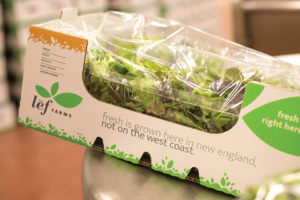How You Can Respond to Complex Consumer Demands for Fresh Veggies

Consumers want different colors, shapes, and most of all, lots of flavor in their vegetables. Photo credit: PanAmerican Seed
Demand for greenhouse-grown produce is steadily rising, with sales in the U.S. expected to reach more than $4 billion by 2020, according to a report by Rabobank’s Food & Agribusiness Research & Advisory group.
Consumers’ push for new choices will put pressure on breeders and growers in this expanding market. Considering that most consumers often can’t tell one variety from another, the growers who will have a competitive edge will be those who differentiate.
Proximity to retail will give greenhouse growers an advantage as the locally grown movement plays more into this market.
“We have had many requests from new and old growers wanting to put up indoor facilities in their region to capture local vegetable sales,” says Joe Messer, North American Manager for Hem Genetics, which recently jumped into the vegetable arena with its ‘Sweet Valentines’ tomato.
Geography is not the only driver of hyper-localism. It’s also about the farm-to-table freshness consumers value, because they equate it with higher quality. lēf Farms in Loudon, NH, has experienced this with local chefs who want something different to set them apart from the kitchen next door.
“We have had great success with our restaurant pack,” says Sales and Marketing Manager Donald Grandmaison. “The chefs like having unique blends of greens delivered just 24 hours after harvest because they can serve a higher-quality product and reduce food waste.”
Flavor Sells
Pinpointing what consumers value in their fresh produce will be the key to getting noticed in the fresh produce market. Currently, flavor ranks at the top of consumer preferences and has become one of the distinguishing factors that make a superb vegetable variety stand out from bland look-alikes.
It also comes down to growers becoming familiar with regional market differences in their area, including specific trends and tastes, says Arjen de Haan, Technical Manager-Europe for Oasis Grower Solutions, a supplier that develops new products and solutions aimed at hydroponic growers.
“Growers have often catered to a generic market in the past, but those growers scoring better will be the ones that aim toward regional taste and culture,” he says.
Gotham Greens is one of the pioneers in urban agriculture, with greenhouse facilities in New York City and Chicago. It has experienced regional success by supplying highly perishable leafy greens and herbs to urban consumers. The company can differentiate its products from other brands and growers because it can offer a fresher, better-tasting product with greater transparency.
“Locally grown produce offers the additional benefits of greater shelf life, increased sell through, overall greater customer satisfaction, and decreased food safety risks,” says Viraj Puri, Co-Founder and CEO of Gotham Greens. “Recent outbreaks of food-borne illnesses like Salmonella and E. coli have only propelled consumers’ demand for greater transparency around how and where their food is produced.”
Yet, it’s still not enough to claim that produce is locally grown. Growers also need to communicate why their growing practices matter in the production of safe food.
“Consumers want transparent labeling and information on the company growing their food and its ethics,” says Sakata’s Product Development and Marketing Manager for Home Garden and Farm Market Vegetables Tracy Lee. “Consumers also want information on the health benefits of fresh produce. This can be a challenge for companies because making health claims is a tricky business.”
Trending Now: Grab-n-Go, Novelty, and Ethnic Veggies
Increased consumer awareness of how their food is grown has also fueled their interest in organically grown vegetables. According to data from the Organic Produce Network, sales of organic fresh produce items reached nearly $5 billion in 2017. Despite organic vegetables’ rise in popularity, organic doesn’t always equate to healthiest, and there is still some confusion about what organic really means.
Equal in value to consumers is uniqueness and convenience. Mini cucumbers, snack peppers, cherry tomatoes, etc., offer easy, grab-and-go options.
“Heirloom vegetables also work well for fresh-produce sales, and ethnic and novelty vegetables are gaining popularity,” says Josh Kirschenbaum, PanAmerican Seed Vegetable Sales Account Manager. “Incorporating different colors, shapes, and flavors into traditional vegetables is becoming more mainstream.”
PanAmerican’s HandPicked Vegetable and Herb Collection is geared especially for those who supply fresh market farms. One convenience product it is currently developing is a seedless sweet pepper. If grown in a greenhouse, isolated from standard peppers, the fruit will be free of seed. This allows consumers to cook the peppers whole without having to worry about removing the seeds.

Sales of fresh, leafy greens have skyrocketed. lēf Farms’ restaurant pack is popular with local chefs who enjoy receiving fresh greens that are delivered just 24 hours after harvest. Photo by lēf Farms.
Greens Are Where It’s At
Consumer demand for leafy greens, such as arugula and romaine lettuce, and micro and baby greens has exploded. Sakata Vegetables is one breeder focusing on the leafy greens and baby greens markets, to find varieties that exhibit superb flavor when grown indoors.
“In addition to flavor, growers want items that will add a percentage of color to their greens, such as red or gold varieties like yellow-stemmed chard. They are also looking to expand into other areas,” Lee says.
Some of these areas include a focus on herbs such as oregano, basil, and rosemary, and hydroponic leafy greens and herbs that are sold with the roots intact.
“By selling greens and herbs this way, growers avoid many of the food safety concerns that occur with cut leaves, and the consumer gets a fresh product that lasts longer than cut products,” Kirschenbaum says.
As growers venture into these new areas and try to make a name for themselves selling greenhouse-grown vegetables for the fresh market, they will need to adopt the more flavorful, distinctive vegetables consumers crave.
Sharing their stories and focusing more on benefit-driven communication will improve their chance for success.
Berries for Fresh Produce Sales
Berries have also become popular products for fresh produce sales. Consumer awareness is increasing about the vague histories of some imported berries as far as pesticide-use and other production and harvesting methods are concerned. This has led to more demand for berries such as greenhouse-grown strawberries raised on benches/gutters in a clean environment because they are more sustainable and labor friendly than field-grown strawberries, according to Adri Gillissen of ABZ Seeds, the company known for the Delizzimo strawberry.










